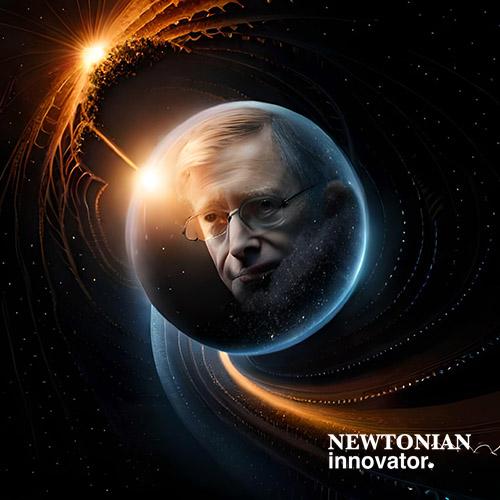One of the most provocative theoretical puzzles in modern physics is the black hole information paradox, conceived by the legendary physicist Stephen Hawking in the 1970s. This paradox proposes a troubling contradiction between quantum mechanics and general relativity around black holes.
Stephen Hawking was born in 1942 in Oxford, England. He displayed remarkable talents early on, graduating Oxford University at age 20 with first class honors in physics despite being diagnosed with ALS at 21. The disease eventually left him paralyzed and unable to speak except through a voice synthesizer.
Hawking obtained his PhD from Cambridge where he studied under Dennis Sciama, developing an interest in the new fields of cosmology and quantum gravity. His thesis was entitled “Properties of Expanding Universes.”
Despite having ALS for over 5 decades, Hawking persevered to become one of history’s greatest physicists. He transcended his physical limitations through sheer force of intellect. Hawking brought acclaim to theoretical physics through bestselling books like A Brief History of Time. His pioneering studies of gravitational singularities and quantum effects in black holes fundamentally advanced cosmology and physics.

Stephen Hawking’s brilliance was defined by his boundless creativity and ability for unconventional thinking. When faced with seeming contradictions in physics theories, Hawking responded not with frustration, but excitement. Each paradox signified an opportunity to advance understanding.
Hawking also leveraged his visual imagination. He thought pictorially rather than through only equations, visualizing concepts like warped spacetime. Hawking then translated these vivid mental images into mathematical formalism. He held a flexible view of physical models, adapting theories as new insights emerged.
Early in his career, Stephen Hawking firmly opposed the notion that information could be destroyed in black holes. He instead believed that quantum effects at the event horizon subtly encoded information about infalling matter into the outgoing Hawking radiation.
The black hole information paradox crystallizes profound mysteries about reconciling gravity and quantum realms. It serves as a guiding light pointing the way towards quantum gravity theory, the holy grail of physics sought by generations of scientists. The imaginative thoughts of Stephen Hawking opened new vistas for considering the nature of reality.
To explain this in layman’s terms, imagine tossing a detailed blueprint into a roaring fire. The information within the blueprint seems to be lost forever as the paper burns away. But in the world of physics, information is never supposed to be lost–it should always exist in some form. Now, think of a black hole like that fire, but with a perplexing twist. According to the rules of quantum mechanics, information about anything that falls into a black hole should somehow be preserved, just like the blueprint’s information should be hidden in the smoke and ashes. Yet, Hawking’s discoveries indicated that this information actually gets completely erased when black holes evaporate away. This dilemma, like trying to reconcile the idea of an indestructible blueprint with one that vanishes without a trace, created a profound puzzle that connected and confused the principles of general relativity and quantum mechanics. This inconsistency is what’s known as the black hole information paradox, and it’s been a tantalizing mystery that has fueled debate and research for decades.
However, by the mid-1970s, Hawking shifted to advocating information destruction as a real possibility. His initial calculations of particle creation near the horizon suggested matter disappeared when dragged into the singularity. After rigorous derivations taking virtual particle behavior and spacetime fluctuations into account, Hawking concluded information was hopelessly lost in black holes.
At the time, many physicists resisted this view, unable to abandon the quantum doctrine of unitary evolution which preserves information. But Hawking stubbornly defended his position for over a decade, insisting black holes caused pure quantum states to evolve into mixed states, similar to information destruction. He sought to reformulate quantum mechanics to allow this violation as quantum mechanics asserts information can never be lost, only transformed. Yet Hawking’s calculations found black holes destroy information, challenging quantum theory.
The roots of this conflict lie in Einstein’s general theory of relativity, which predicts the existence of black holes from gravitational collapse. Hawking combined quantum effects with general relativity and discovered even black holes emit radiation. But there was a catch, this radiation from a black hole depends only on the hole’s properties like mass, charge, and spin. It does not encode information about the matter that originally formed the black hole.
So when black holes fully evaporate away due to Hawking radiation, any information about material consumed by the black hole disappears–completely erased in violation of quantum mechanics. This discovery by Hawking touched off a fierce debate in theoretical physics spanning decades. How could the pivotal theories of general relativity and quantum mechanics lead to such contradictory conclusions about information?
Combining quantum field theory with general relativity, Hawking demonstrated that black holes emit radiation. This radiation causes black holes to lose energy and slowly shrink over time. His calculations relied on the uncertainty principle–vacuum fluctuations near the event horizon could allow particles to escape as radiation. This radiation became known as Hawking radiation and its discovery was a major breakthrough in theoretical physics.
Hawking also collaborated with Roger Penrose on singularity theorems proving spacetime singularities form within black holes. Hawking’s work showed these singularities and black holes themselves were not completely black, but could glow and eventually evaporate.
An example was Hawking’s shift regarding black hole event horizons. At first he viewed the horizon as a definitive barrier, even proposing particles created at the horizon radiated outward. But stimulated by new concepts like quantum tunneling, Hawking reversed course. He adopted the radical idea that black holes emit radiation from their interior, renaming the apparent horizon.
In the 1990s and 2000s, Hawking wavered again based on new theorizing and proposals like the AdS/CFT correspondence. He reluctantly adopted the information preservation perspective, though not fully relinquishing the possibility of information loss. Hawking proposed subtle correlations between particle pairs emitted from black holes could theoretically encode information after all. His changing perspectives reflected his openness to evolving his conclusions in response to new insights.
This conflict touches on profound issues at the intersection of gravitation, thermodynamics, and information theory. It underscores gaps in the Standard Model and prompts important conceptual questions. Are there physical processes that cannot be deterministically reversed? Does information have an ultimate physical reality? The paradox stirs foundational debate about causality and the ontological nature of information.
Most importantly, the contradiction highlights the key challenge of unifying gravity with the quantum realm. Quantum effects like entanglement and superposition crucially depend on unitarity – the principle that information must be conserved. General relativity appears to allow clear violations of this principle. Resolving this conflict is widely believed to require a theory of quantum gravity merging these frameworks.
The black hole information paradox acts like a lighthouse illuminating the elusive shore of quantum gravity theory. It provides essential clues and guiding insights to physicists exploring quantum-gravitational phenomena. Understanding information preservation in black holes will likely emerge only from a successful unification of quantum mechanics and general relativity. Solving Hawking’s provocative paradox may thus lead to the holy grail of theoretical physics – a quantum theory of gravity that eluded even Einstein.
Seeking ways to incorporate gravity into quantum theory has also motivated proposals like loop quantum gravity. This suggests space consists of discrete Planck-sized “grains”. Such granular spacetime may mean matter cannot compress into true singularities, eliminating black hole information paradoxes. By stimulating theoretical creativity, Hawking’s provocative dilemma drives progress towards quantum gravity.
Hawking’s paradox also opens the door to reshaping astrophysical theory more broadly. Modified theories of gravity like MOND posit galaxies follow different gravitational laws than standard relativity predicts. This seems to better model observed galaxy rotation speeds. Could modifying gravity theory lead to resolving the black hole information paradox without quantum effects? Exciting discoveries surely await physicists willing to question orthodox theories.

The Bet: In 1997, Stephen Hawking and Kip Thorne bet John Preskill that information falling into a black hole is lost, contradicting Preskill’s belief in information conservation. The playful wager promised a set of baseball encyclopedias to the winner.
The Debate: The bet ignited debate over the conflict between general relativity and quantum mechanics. Hawking’s stance, based on his calculations about black hole radiation, seemed to violate quantum principles, creating a paradox.
Conceding the Bet: In 2004, Hawking conceded, influenced by new theories, and admitted that information could escape black holes. He gave Preskill a baseball encyclopedia, symbolizing the resolution.
Contributing to Science: The bet stimulated curiosity and collaboration, highlighting a fundamental paradox and encouraging exploration and debate. It symbolized the spirit of inquiry, celebrating differing opinions as catalysts for discovery.
Challenging Ourselves Today: Inspired by Hawking’s bet, we can embrace intellectual challenges and foster respectful disagreement. This approach nurtures creativity and innovation, reminding us that science thrives on diverse perspectives and the courage to question the status quo.
Towards the end of his life, Hawking leaned back towards believing information vanishes in black holes. While Hawking fluctuated in his views, he brought constant creativity, intellectual honesty, and philosophical depth to resolving this quantum gravity paradox. His penetrating analysis shaped modern comprehension of black holes. The black hole information paradox exemplifies how exploring contradictions between fundamental theories can uncover the path to new physics. Hawking’s finding that black holes destroy information revealed an incompatibility between the two great pillars of modern physics – general relativity and quantum mechanics.
In the end, the greatest progress often arises from wrestling with paradoxes rather than fleeing from them. Pondering creative new hypotheses and imaginative concepts guides us towards truth. Einstein himself said, “Imagination is more important than knowledge. For knowledge is limited, whereas imagination embraces the entire world.” Following Hawking’s spirit of intellectual exploration will surely uncover profound new revelations about time, space and knowledge.
Stephen Hawking’s approach to the black hole information paradox epitomizes a methodology that modern scientists should seek to emulate. His imaginative and visual thinking, unorthodox perspectives, and willingness to engage with friendly bets that prompted unprecedented breakthroughs. Hawking’s example encourages us to see conflicts and contradictions not as insurmountable barriers, but as gateways to deeper understanding. His intellectual flexibility and courage to change opinions in the face of new insights remind us that scientific progress is an evolving journey, not a static destination. By fostering creativity, curiosity, and a relentless pursuit of truth, today’s scientists can continue to expand the horizons of our knowledge and understanding, drawing inspiration from one of history’s most profound minds.






